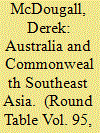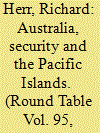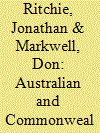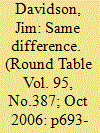|
|
|
Sort Order |
|
|
|
Items / Page
|
|
|
|
|
|
|
| Srl | Item |
| 1 |
ID:
075789


|
|
|
|
|
| Publication |
2006.
|
| Summary/Abstract |
Australia has historical links to the contemporary states of Malaysia, Singapore and Brunei through the British Empire and Commonwealth. While Australian relations with these countries in more recent times have been influenced by a range of factors, the Commonwealth connection remains significant. Politico-cultural tensions complicated the Australian relationship with Malaysia during the Mahathir era from 1981 to 2003. Nevertheless, the substantive aspects of the relationship remained strong. There was potential for cultural tensions in the relationships with Singapore and Brunei but no major rifts developed; Singapore has been a key partner for Australia in the region. Thus Australia has strong relationships with the three states of Commonwealth Southeast Asia in the areas of security, economics and education, with the imperial and Commonwealth past being a contributing factor in each case
|
|
|
|
|
|
|
|
|
|
|
|
|
|
|
|
| 2 |
ID:
075786


|
|
|
|
|
| Publication |
2006.
|
| Summary/Abstract |
Australia and New Zealand (Aotearoa) have shared almost two centuries of close relations created through close geographic proximity, shared membership of political associations, and frequent policy exchange. The relevant context has shifted from the British Empire and Commonwealth to a rapidly globalizing world under US military hegemony. Australia and New Zealand were among the early settler colonies of the British Empire and this article argues that, as such, the settler colonies helped shape the form of the Empire, and subsequently the Commonwealth. This history created strong, separate, if somewhat similar, traditions of independent political experimentation. This article explores different models for explaining the cross-Tasman relationship and concludes that the path-dependent approach works best. The path was also influenced by external shocks, notably the second world war and Britain's moves towards Europe, and it was these shocks that created the necessary ruptures to create change. The first world war had catapulted Australia and New Zealand towards separate nationhood, and simultaneously strengthened their cultural and political links. The second world war pushed Australia towards the USA and led both Australia and New Zealand to develop a more explicit role as regional leaders in the Pacific. For New Zealand, Britain's membership of the European Community created an economic crisis and politico-cultural stresses which are reverberating still. Such shocks created the preconditions also for closer association, exemplified in the CER Treaty, which in turn draws upon historical precedents and experiences.
|
|
|
|
|
|
|
|
|
|
|
|
|
|
|
|
| 3 |
ID:
075788


|
|
|
|
|
| Publication |
2006.
|
| Summary/Abstract |
While Australia did not single-handedly scuttle the prospects of a more tightly knit Commonwealth arrangement in the Pacific Islands, its security ambitions have worked against the development of such ties. This article identifies three key turning points, beginning from 1944, where Australia opted for alliance arrangements that undermined closer Commonwealth ties with and among the Pacific Islands. As the region's hegemonic influence, Australia's decisions have been a significant factor in shaping the contemporary Pacific Islands regional system. Canberra's active commitment and backing would have been essential for closer Commonwealth connections to be developed in this varied and remote region. Yet Australia's search for security in the Southwest Pacific has denied the Commonwealth the benefit of such unqualified support. Commonwealth ties are still a factor within the Pacific Islands region in such areas as contemporary political relationships, including the maintenance of Westminster traditions, but they are probably not what they might have been.
|
|
|
|
|
|
|
|
|
|
|
|
|
|
|
|
| 4 |
ID:
075790


|
|
|
|
|
| Publication |
2006.
|
| Summary/Abstract |
When republics, beginning with India in 1949, were first admitted to the Commonwealth of Nations, Australia remained strongly attached to the Crown and the King's (later the Queen's) role as Head of the Commonwealth. Indeed, many Australians had seen a shared Crown as axiomatic, and a symbol of Commonwealth unity. Despite bursts of republicanism in Australia during the 19th and 20th centuries, it was not until the 1990s that a republic appeared likely. One historic driver of anti-British Australian republicanism has been the Irish heritage of many Australians. As republicanism grew, it was important that Australia could remain in the Commonwealth as a republic. The past decade has seen a stronger sentiment in Australia than in the other 'old Dominions' - New Zealand and Canada - that national independence and identity require the symbol of a home-grown head of state, rather than one seen as British. The growth of republicanism in such countries, and in Britain itself, would be likely to encourage republicanism in Australia. Australia's republican majority has been frustrated by its inability to agree on a model for parliamentary selection or direct election of the president. No Commonwealth country provides a model which Australians find compelling.
|
|
|
|
|
|
|
|
|
|
|
|
|
|
|
|
| 5 |
ID:
075787


|
|
|
|
|
| Publication |
2006.
|
| Summary/Abstract |
Australia's relationship with South Africa was founded on their being two groups of colonies, and later dominions, in the British Empire. As remote settler societies there were certain affinities, anxiously promoted by South Africa and usually resisted by Australia. Australian prime ministers played a major role in helping to bring about majority rule, but since 1994 the relationship has stiffened. For South Africa, partly for geopolitical reasons, the Commonwealth remains a functional concept; for Australia, it has lost much of its efficacy. Australia and South Africa have also exchanged two significant migrations: of Australian miners and artisans to the Rand around the turn of last century, and of South African emigrants to Australia in our own time. Trade between the two countries is increasing, and a new range and diversity in contact has occurred, with the resumption of full relations since the apartheid years. Given South Africa's disjunction from its immediate past, it is difficult at present to indicate what forms the relationship might take in future. The paper therefore sketches the whole history of interaction between the two countries, drawing attention to its phases and reconfigurations
|
|
|
|
|
|
|
|
|
|
|
|
|
|
|
|
|
|
|
|
|